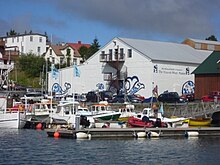Whale Museum in Húsavík
The Whale Museum in Húsavík ( Icelandic Hvalasafnið á Húsavik ) is a museum in the Icelandic city of Húsavík .
It was founded in 1997 with the aim of educating the public about whales. The exhibition focuses on the biology and threats to whales found in Icelandic waters. Separate themed rooms provide insights into the history of Icelandic whaling , whale watching , whale stranding and natural history . In addition, numerous skeletons illustrate the anatomy and size of various whale species. The village is located in the north-east of Iceland on the coast of Skjálfandi Bay, a little below the Arctic Circle.
history
The history of the museum began in the summer of 1997 with a small exhibition on whales in a hotel in Húsavík. A short time later, the exhibition was housed in rented rooms directly at the port. At the same time, the Húsavík Whale Center ehf company was founded. Due to the increasing interest in the museum, a larger building was required after only three years. In 2000, a former slaughterhouse was bought. This was built in 1931 and had been empty since the 1980s. This was rebuilt and opened as a museum in June 2002. Unpaid help from a large number of locals was fundamental to the museum's success. In 2004 the joint-stock company was transformed into a non-profit organization called the Whale Museum in Húsavík . In 2007 the museum was recognized as an educational institution by the Icelandic Ministry of Education.
exhibition
The museum has an exhibition area of 1600 m², which extends over two floors. On the lower floor there is an exhibition section on the marine ecosystem as well as the habitat and ecology of whales . In addition, you will find information about different whale species in the North Atlantic as well as separate rooms on the topics of whale strandings, natural history, whale watching, whaling and dolphins . The killer whales - including Keiko , the most famous Icelandic killer whale - have a separate room. Two films provide background information on whaling. The museum's “whale gallery” is located on the upper floor. Skeletons of a total of 9 different species are exhibited there. The first skeleton in the collection dates from 1998 and belongs to a Sowerby two-toothed whale (Mesoplodon bidens). Over time, the collection has been expanded to include skeletons of the following whale species: minke whale (Balaenoptera acutorostrata), sperm whale (Physeter macrocephalus), humpback whale (Megaptera novaeangliae), killer whale (Orcinus orca), Cuvier's beaked whale (Ziphius cavirostris), northern duck whale (Hyperoodon) ampullotus) and pilot whale (Globicephala melas). In 2004 a Narwhal skeleton (Monodon monoceros) was donated to the Museum of Greenland . In 2005 the exhibition was expanded to include a new section on the ecology of whales. In 2009 a section on the history of the slaughterhouse and the museum was added.
Volunteer Program
The museum has had a program with international volunteers since the beginning. As a rule, the volunteers are students from different disciplines with a predominantly scientific background. In addition to the daily museum operations, whale research is an essential part of their work. In addition, they take on tasks such as translating texts and guided tours in various languages. They update and expand the exhibition, catalog exhibits and help with the maintenance of the museum building. This gives the volunteers the opportunity to learn more about whales and observe them in the wild.
Whale research
The Whale Museum began research in 1998, but then passed the collected data on to another institution. The museum has had its own database since 2001. Thanks to the collaboration with the local whale watching provider North Sailing , the museum employees have the opportunity to collect data on the whale watching boats on a daily basis. There is a collaboration with universities and researchers who use the data for further studies. The museum's research program focuses on photo identification, but also includes habitat and breathing pattern studies of whales.
See also
Web links
Coordinates: 66 ° 2 ′ 48.6 " N , 17 ° 20 ′ 41" W.




